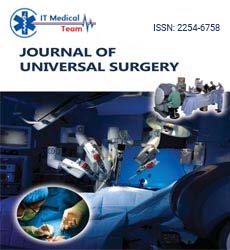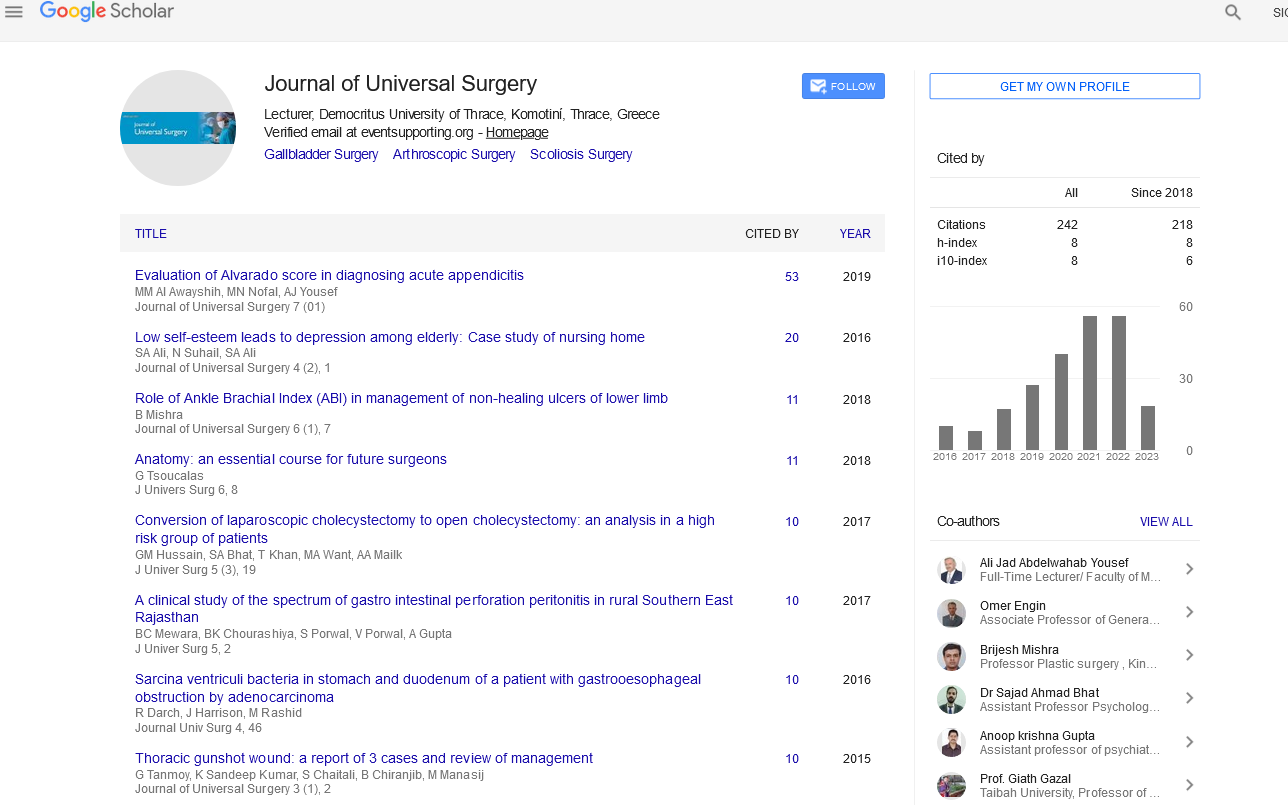Review - (2023) Volume 11, Issue 4
Lidocaine continuous incision in pediatric patients after open heart surgery
Fernández Sarah Nicole*
Department of Paediatric Intensive Care, Hospital General Universitario Gregorio Marañón, Madrid, Spain
*Correspondence:
Fernández Sarah Nicole, Department of Paediatric Intensive Care, Hospital General Universitario Gregorio Marañón, Madrid,
Spain,
Email:
Received: 03-Apr-2023, Manuscript No. IPJUS-23-13580;
Editor assigned: 05-Apr-2023, Pre QC No. P-13580;
Reviewed: 19-Apr-2023, QC No. Q-13580;
Revised: 21-Apr-2023, Manuscript No. R-13580;
Published:
28-Apr-2023
Abstract
Continuous infusion of lidocaine through the incision has been suggested
as adjunctive therapy in the management of postoperative pain in adult
patients. The aim of this study was to determine the efficacy and safety
of continuous subcutaneous infusion of lidocaine in pediatric patients
following open-heart surgery. All patients who received a subcutaneous
lidocaine infusion at the midline of the sternum incision after open
heart surgery for 2 consecutive years were included in the study. A
historical patient group was used as a control group. Demographic
variables (age, height, and surgical procedure), variables related to
sedation and analgesia (COMFORT and analgesia scale, drug dose and
duration), and complications were analyzed. Record 106 patients in
the lidocaine infusion group and 79 patients in the control group were
included. Incisional analgesia was effective in treating pain by reducing
the dose and duration of intravenous fentanyl administration (odds
ratio (OR) 6.26, 95% confidence interval respectively. The reduction in
fentanyl consumption was greater in children over two years of age.
Adverse events were observed in three children (2.8%): all of them had
decreased consciousness and one of them also had seizures. Two of
these three patients had lidocaine levels above 2 mcg/mL. Continuous
infusion of lidocaine into the incision is effective for the treatment of
pain following open heart surgery.
Keywords
Appendix Surgery; Arthroscopic Knee; Colorectal Surgery;
Endometriosis Surgery
INTRODUCTION
This procedure has reduced the need for intravenous
analgesia in pediatric patients undergoing midstream
incision. Despite the low incidence of adverse events,
neurological status and blood lidocaine levels should be
monitored in all patients. Adequate postoperative analgesia
is essential, especially after sternotomy in pediatric patients.
Pain management in the postoperative period includes
intravenous analgesics such as opioids, non-steroidal antiinflammatory
drugs, metamizole and paracetamol [1].
However, in recent years, several authors have proposed
a multimodal approach that combines intravenous drugs
with local techniques such as epidural, nerve block, or
local anesthesia. Continuously into the incision [2]. to
improve the analgesia and analgesic effect. Reduce side
effects. Incisional analgesia is the continuous infusion of a
local anaesthetic into the subcutaneous tissue of a surgical
wound through a catheter placed during surgery [3].
Several studies performed in adults show the effectiveness
of incisional analgesia in reducing postoperative pain in
different types of surgery, including open heart surgery [4].
However, there is limited evidence for its use in pediatric
patients. The purpose of our study was to determine the
efficacy and safety of continuous subcutaneous infusion of
lidocaine in pediatric patients following open heart surgery
[5]. A prospective observational study was performed
that included all patients who received lidocaine infusion
through an incision into the midline incision after cardiac
surgery who were admitted to a pediatric intensive care
unit (ICU). PICU) for two consecutive years. A total of
106 patients were enrolled and classified according to the
RACHS1 (Risk Assessment for Congenital Heart Surgery)
scale [6]. Outcomes were compared with a historical
control group of 79 non-injured patients admitted to the
hospital following cardiac surgery between January 1, 2011
and December 31, 2011 [7].
DISCUSSION
A catheter is inserted through the surgical incision during
surgery after closure of the sternum cut. An elastomeric
infusion pump was used to infuse 0.5% lidocaine [8]. The
infusion rate was adjusted for the patient's weight. The
following demographic variables were collected: age, sex,
type of heart disease and surgery, length of stay in PICU,
operating room extubation (OR), duration of breathing
machine (in hours), dose and duration of incisional
lidocaine administration, lidocaine-related complications,
concomitant intravenous sedation with midazolam or protocol, and concomitant intravenous analgesia with
fentanyl, metamizole or paracetamol [9]. Specific scales
were used to determine sedation (COMFORT scale)
[Data analyzed using IBM SPSS Statistics 19 program
[10]. Qualitative variables are expressed as percentages
and quantitative variables are expressed as medians and
interquartile ranges (IQRs), as the variables do not follow
a normal distribution. The chi-square test was used to
compare qualitative variables and the Mann-Whitney test
to compare the mean between groups. Values less than 0.05
were considered statistically significant. A multivariate
analysis with logistic regression adjusted for age, RACHS1
(Risk Adjusted for Congenital Heart Surgery) score, and
operating room extubation. An age stratified analysis was
also performed, with a threshold of two years. One hundred
and six children were included in the study. Median age was
63 months (IQR 35-98 months) and 21.7% were under
two years of age. 90 patients (84.1%) were extubated after
surgery in the operating room. 86% of patients admitted
to a mechanically ventilated PICU hospital were extubated
within the first 24 hours of admission. The mean duration
of intravenous lidocaine infusion was 48 hours (IQR 48-
72). The mean infusion rate was 3 ml/hr (IQR 2-5 ml/
hr). Lidocaine blood levels were determined between 12
and 48 hours after admission in 58 patients. Blood levels
were above 1.5 mcg/ml in 18 patients (31%), but none of
them had levels above 5 mcg/ml. None of the patients had
liver dysfunction. Six patients (5.6%) had complications
related to analgesia. Three patients had problems with
catheter misplacement and peritubular leaks leading to
early catheter removal.
CONCLUSION
Three other patients (2.8%) had neurological
complications: A 4-month-old infant presented with
decreased consciousness and tonic-clonic seizures.
An 11-month-old patient presented with decreased
consciousness. Both had elevated serum lidocaine
concentrations (3.8 and 2.4 mg/dl, respectively). Cranial
ultrasonography and 12-lead EEG were normal in both
patients and neurologic findings disappeared after surgical
analgesia was discontinued. The third patient, a 17-year-old
male, presented with acute delirium, but was considered
unrelated to incisional analgesia because the infusion had
been stopped several days earlier and the lidocaine blood
level was 1.1 mg/dl. No hemodynamic side effects were
observed during the study. This study aimed to assess the
need for BMI as a stratification factor for patients in PAS
clinics. The results of this study demonstrate that surgical
grade rather than BMI is an independent risk factor for
global complications. When the cohort was stratified by
surgical grade, BMI remained an insignificant factor
in overall complications. Currently, there is conflicting
evidence about the importance of BMI as a risk factor
for postoperative complications. Evidence suggests that
obese patients undergoing surgery for an indication for
malignancy have a higher risk of complications. However,
this increased risk was not observed in patients undergoing
surgery for a benign indication. These results demonstrate
that obese patients undergoing surgery for an indication
for malignancy may need to be seen in high-risk clinics.
A systematic review of patients undergoing laparoscopic
colorectal surgery concluded that BMI was not a predictor
of increased incidence of postoperative complications or
length of hospital stay.
REFERENCES
- Stevenson TH, Castillo A, Lucia LM, et al. Growth of Helicobacter pylori in various liquid and plating media. Lett Appl Microbiol. 2000;30: 192-6.
Indexed at, Google Scholar, Crossref
- Lawrence CM, Menon S, Eilers BJ, et al. Structural and functional studies of archaeal viruses. J Biol Chem 2009;284: 12599-603.
Indexed at, Google Scholar, Crossref
- Cook S, Moureau G, Harbach RE, et al. Isolation of a novel species of flavivirus and a new strain of Culex flavivirus from a natural mosquito population in Uganda. J Gen Virol. 2009;90: 2669-78.
Indexed at, Google Scholar, Crossref
- Stapleford Kenneth A, Miller David J. Role of Cellular Lipids in Positive-Sense RNA virus Replication Complex Assembly and Function. Viruses. 2010;2: 1055-68.
Indexed at, Google Scholar, Crossref
- Stanley WM, Loring HS. the Isolation of Crystalline Tobacco Mosaic Virus Protein from Diseased Tomato Plants. Science. 1936;83: 85.
Indexed at, Google Scholar, Crossref
- Creager AN, Morgan GJ. After the double helix: Rosalind Franklin's research on Tobacco mosaic virus. Isis. 2008;99: 239-72.
Indexed at, Google Scholar, Crossref
- Temin HM, Baltimore D. RNA-directed DNA synthesis and RNA tumor viruses. Adv Virus Res. 1972;17: 129-86.
Indexed at, Google Scholar, Crossref
- Barré-Sinoussi F, Chermann JC, Nugeyre MT, et al. Isolation of a T-lymphotropic retrovirus from a patient at risk for acquired immune deficiency syndrome (AIDS). Science.1983;220: 868-71.
Indexed at, Google Scholar, Crossref
- D'Herelle F. on an invisible microbe antagonistic toward dysenteric bacilli: brief note by Mr F D'Herelle, presented, Mr Roux. Res Microbiol. 2007;158: 553-54.
Indexed at, Google Scholar, Crossref
- Jugder BE, Watnick PI. Vibrio cholera Sheds Its Coat to Make Itself Comfortable in the Gut. Cell Host & Microbe. 2020; 27: 161-163.
Indexed at, Google Scholar, Crossref





